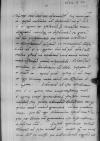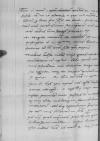Dominus ⌊Fasolt⌋ reddidit mihi fasciculum, in quo litterae Dominationis Vestrae Reverendissimae et ⌊⌋ ⌊Ioannis Campensis⌋ erat obsignatum utrumque et desideratum et gratum, nam hoc perspicuitate sua captivat intellectum in contemplationem caelestium et terrenorum contemptum. Litteris vero Dominationis Vestrae Reverendissimae, dici non potest, quantum oblectabar, quibus, ne eruditas eius aures neniis meis offendam, paucis respondebo. Gedanensium excusatio de contributione non danda suscepta est a ⌊maiestate regia⌋, apud quam reverendissimus ⌊dominus noster Cracoviensis⌋ et ego iuvimus vota eorum, ut consuluit Dominatio Vestra Reverendissima. Libertatem ab ista contributione pro Dominatione Vestra Reverendissima iam impetrassemus, nisi ⌊dominus reverendissimus Cracoviensis⌋ perturbatus fuisset morte nepotuli sui, pueri admodum dulcissimi et quae praeter aetatem morum gravitate velut matura erat, ieci tamen ego fundamenta apud ⌊maiestatem regiam⌋, quae, ut conicio, non gravatim est assensura desiderio nostro. ⌊Fasolt⌋ obtinuit salvum conductum ad festa Natalis Domini, scriptae quoque in eius rem litterae et missae per cubicularium regium ad
 BCz, 1595, p. 450
illustrem ⌊dominum ducem⌋, quem hortatur ⌊maiestas regia⌋, ut, cum Fasolt non vi et potentia, a qua eum maiestas regia liberum pro bono suae illustritatis et facit, iuris ordine hidden by binding⌈[e]e hidden by binding⌉ vel coram paribus curiae suae primum vel iam coram communibus commissariis procedat etc.
BCz, 1595, p. 450
illustrem ⌊dominum ducem⌋, quem hortatur ⌊maiestas regia⌋, ut, cum Fasolt non vi et potentia, a qua eum maiestas regia liberum pro bono suae illustritatis et facit, iuris ordine hidden by binding⌈[e]e hidden by binding⌉ vel coram paribus curiae suae primum vel iam coram communibus commissariis procedat etc.
De negotio Varmiensi ita curabitur per me, ut hidden by binding⌈[ut]ut hidden by binding⌉ praescripsit Dominatio Vestra Reverendissima, cuius honor et fortunae tam mihi cordi sunt, quam propriae.
⌊Nicolaus Holste⌋ malam iniit gratiam apud me hidden by binding⌈[e]e hidden by binding⌉ commendatione Vestrae Dominationis Reverendissimae. Dabo operam, ut eius petulantia aut vecordia ⌊regiae maiestati⌋ sit cognita resque ita tractetur, quemadmodum hidden by binding⌈[um]um hidden by binding⌉ se gerit. Et haec ad litteras Vestrae Reverendissimae Dominationis hidden by binding⌈[Dominationis]Dominationis hidden by binding⌉.
Iam de his, quae apud nos aguntur, dicunturve hidden by binding⌈[ve]ve hidden by binding⌉, pauca attingam. Dominus ⌊castellanus Cracoviensis⌋ iam extra periculum vitae positus dicitur a medicis(?), cuius obitu videbamus et formidabamus hidden by binding⌈[s]s hidden by binding⌉ mutationem. Sed Deus exaudivit preces nostras hidden by binding⌈[s]s hidden by binding⌉, sit nomen eius benedictum in saecula. ⌊Serenissimi princi hidden by binding⌈[inci]inci hidden by binding⌉pes nostri⌋, quod imprimis scribendum erat superinscribed⌈eraterat superinscribed⌉, Deo gratiae bellissime valent. ⌊Caesar Turcarum⌋ scri hidden by binding⌈[scri]scri hidden by binding⌉psit ovantes litteras ad ⌊maiestatem regiam⌋, cui se amicum hidden by binding⌈[icum]icum hidden by binding⌉
 BCz, 1595, p. 451
pollicetur, sed in futuram aestatem se eum valido exercitu contra ⌊caesarem⌋ et ⌊fratrem⌋ eius ⌊Imbraimbassam⌋ mittere comminatur. Exercitus, qui erat per regem ⌊Ferdinandum⌋ ad ⌊Ungariam⌋ missus, exorta dissensione inter ⌊Cacianerum⌋ capitaneum et praefectum cohortis Italicae (qui manu et pede mutilatus superinscribed in place of crossed-out multatus⌈multatus mutilatus mutilatus superinscribed in place of crossed-out multatus⌉ est) dissolutus dissipatusque esse scribitur. Cuius metu, quod obsessurus ⌊Budam⌋ putabatur, ⌊Ludovicus Gritti⌋ appulit Budam cum quinquaginta milibus ⌊Turcorum⌋, qui procul dubio absque illato damno non redibunt ad sua. ⌊Maiestas regia⌋ curat ⌊istos principes⌋ inducere ad tractandam concordiam, qua ratione misit dominum nostrum(?) ⌊Nipczycz⌋ ad ⌊regem Romanorum⌋, nam rex ⌊Ioannes⌋ annuit, ut tractetur pax vel in aula ⌊maiestatis regiae⌋, vel in ⌊regno Poloniae⌋.
BCz, 1595, p. 451
pollicetur, sed in futuram aestatem se eum valido exercitu contra ⌊caesarem⌋ et ⌊fratrem⌋ eius ⌊Imbraimbassam⌋ mittere comminatur. Exercitus, qui erat per regem ⌊Ferdinandum⌋ ad ⌊Ungariam⌋ missus, exorta dissensione inter ⌊Cacianerum⌋ capitaneum et praefectum cohortis Italicae (qui manu et pede mutilatus superinscribed in place of crossed-out multatus⌈multatus mutilatus mutilatus superinscribed in place of crossed-out multatus⌉ est) dissolutus dissipatusque esse scribitur. Cuius metu, quod obsessurus ⌊Budam⌋ putabatur, ⌊Ludovicus Gritti⌋ appulit Budam cum quinquaginta milibus ⌊Turcorum⌋, qui procul dubio absque illato damno non redibunt ad sua. ⌊Maiestas regia⌋ curat ⌊istos principes⌋ inducere ad tractandam concordiam, qua ratione misit dominum nostrum(?) ⌊Nipczycz⌋ ad ⌊regem Romanorum⌋, nam rex ⌊Ioannes⌋ annuit, ut tractetur pax vel in aula ⌊maiestatis regiae⌋, vel in ⌊regno Poloniae⌋.
⌊Valdesius⌋ peste absumptus est et ⌊Viennae⌋ sepultus. Spero, quod noster ⌊Cornelius⌋ succedet illi. Haec sine ordine, sine phaleris et quemadmodum ad buccam venerunt, ad Dominationem Vestram Reverendissimam perscribere coactus sum, temporis angustia et negotiis pressus. Valeat et sit felix Vestra Reverendissima Dominatio meque comnendatum apud se habeat.
 BCz, 1595, p. 450
illustrem
BCz, 1595, p. 450
illustrem  BCz, 1595, p. 451
pollicetur, sed in futuram aestatem se eum valido exercitu contra
BCz, 1595, p. 451
pollicetur, sed in futuram aestatem se eum valido exercitu contra 


